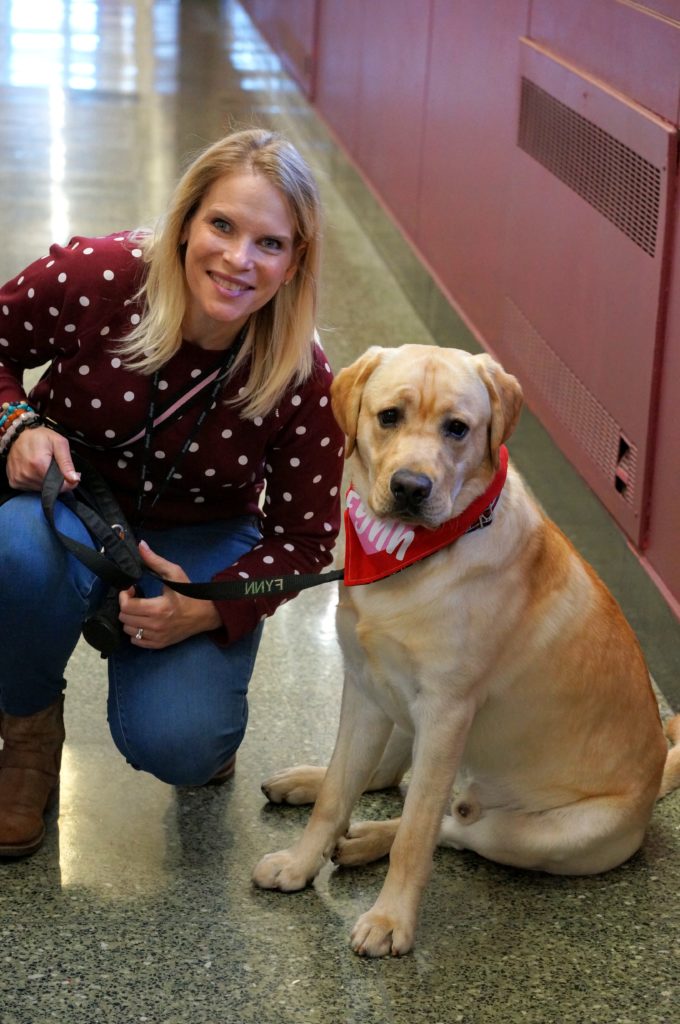Lauren Martini, Occupational Therapist at The Phoenix Center (an accredited non-profit, private school that serves nearly 140 students ages 5-21 with autism, multiple disabilities, behavioral and intellectual disabilities) and her therapy dog Fynn, a Yellow English Lab, are redefining how they approach students’ OT and therapeutic sessions.
For children with disabilities, especially those with a diagnosis of autism, animal-assisted therapy (AAT) has become increasingly popular. Why? Because it’s often easier for kids on the spectrum to relate to animals than other people. According to a 2017 research from the University of Cambridge, children derive greater satisfaction from relationships with their pets than with their brothers or sisters!
Why do you think that is? Have you ever noticed that people smile more around dogs? Do they just make us happier? A recent Harvard Medical School Health research report shows that the health benefits of owning a dog include lower blood pressure and healthier cholesterol levels, and a lower risk of heart disease (vs. non-owners). The psychological benefits of being a dog owner include being less prone to bouts of loneliness, anxiety, and depression.
Animal-assisted therapy, also known as pet therapy, or the use of pets – dogs, mostly, but also a few cats – to mitigate disabilities dates back (at least) to the 1960s. Today, pets are used to ease anxiety and promote healing in hospital settings, as well as part of esteem-building therapies for special needs adults and children.
AAT involves any variety of therapeutic interventions which focus on interactions between a person and an animal with the goal of improving physical, cognitive, emotional, or behavioral problems. Unlike service dogs, therapy dogs work to assist in the therapeutic rehabilitation of individuals. This includes focus on the cognitive, emotional, social, and sometimes physical aspects of therapy. As a result, therapy dogs must be well-tempered, well-socialized, and comfortable in busy or chaotic situations. This is precisely why therapy dogs do so well in a special needs educational environment.
A study by the International Journal of Environmental Research & Public Health aggregated studies conducted on AAT in the classroom and demonstrated that the majority of the studies reported beneficial effects on cognitive and socio-emotional behaviors and physiological responses.
There were 841 articles and studies reviewed for this research report, some of which specifically indicated that animal intervention has a role to play in academic engagement, reading skill, emotional stability and learning, social function and interpersonal skills, physiological arousal, motor skills and adherence to instructions during motor and memory tasks, object recognition and overall classroom behavior.
To that end, therapy dogs can play an important role in the classroom, especially for children on the spectrum. Here are some of the benefits:
1- Encourage calm in an anxious or nervous situation. When a child starts to demonstrate anxiety or nervousness, a trained therapy dog knows to come close to the child, often making physical contact and applying physical pressure, which interrupts and distracts the child–enabling them to de-escalate the situation and encourages self-regulation.
2- Make ”physical play more fun.’’ A therapy dog can be utilized to encourage children to complete more strenuous activities by “pulling’’ or “pushing’’ things for any length of time to get moving. For example, a therapy dog sitting on a skateboard can be compelling enough to prompt the student to pull him around the classroom or down the hallway. The student becomes so distracted by the game of pulling a dog on a skateboard that they forget they are doing strenuous Occupational or Physical Therapy at the same time. This type of work is often part of the curricula for students with multiple disabilities, so this can significantly impact the success of their sessions and their school experiences.
3- Inspire emotional expression. Therapy dogs have been shown to elicit emotional expression among children that typically have trouble with engagement, touch and emotion, like those with Autism Spectrum Disorder (ASD), and can often be considered an indicator of growth and progression.
4- Encourage socialization. Working with a therapy dog can promote socialization in individuals on the spectrum. This work can elicit spontaneous verbalization to/with the dog, which can be capitalized on by the therapist to encourage even more communication with peers and trusted adults.
5- Enable the experience of touch. Students with sensory issues that may not be comfortable with being touched by another person often nuzzle and hug a therapy dog. Often, students are encouraged to groom therapy dogs which is another way of promoting physical touch, which can be a big challenge for students on the spectrum. Touch and sensory experiences are important parts of the Physical Therapy and Occupational Therapy learning process.
Students can be seen “lighting up’’ when interacting with therapy dogs. And because therapy dogs are completely non-threatening, non-judgmental and have zero expectations of the children, the students communicate with the dogs on their own terms, opening the door for better communication with other people. It’s amazing to see the kind of impact working with a therapy dog can have on the educational community
Here are some brief video clips for your reference:
https://drive.google.com/file/d/1OZqffreDh5obCr4Hj3WRUjRIkAa8kpXQ/view?usp=sharing
https://drive.google.com/file/d/19UMV7WIIpG-UprUVS_PyFartusGxlkmq/view?usp=sharing




